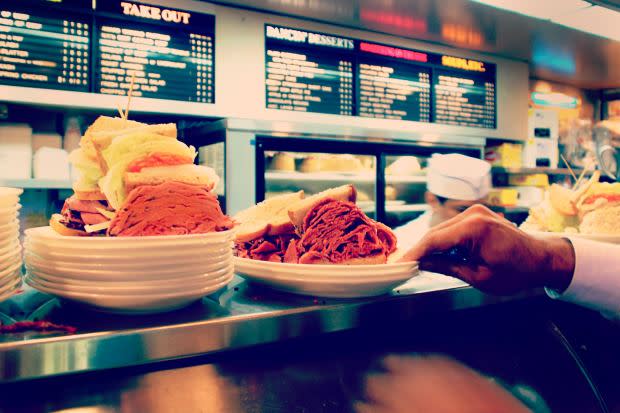Pastrami vs. Corned Beef: What's the Difference, Exactly?
If you've ever had a Reuben sandwich, you understand why the sandwich is so popular. The classic Reuben is made on rye bread and piled high with corned beef, sauerkraut, Swiss cheese and Russian or Thousand Island dressing. It's a delicious combination that gets the mouth watering just thinking about it. Besides corned beef, many people use pastrami instead for a very similar taste. In fact, it's quite easy to confuse the two types of deli meat—they look very similar to each other and both are a type of brisket. However, when it comes to pastrami vs. corned beef, there are some slight differences that would make you choose one over the other.
Neither of the two types of deli meat would be considered a healthy choice. However, if you are watching your sodium intake, you would want to choose pastrami as it is lower in sodium than corned beef. On the other hand, corned beef has lower cholesterol than pastrami. What it really boils down to is that you just need to pick your poison. The key is to enjoy either one in moderation and consider it a splurge from your normal diet.
Besides the nutritional value, there are other differences between these two popular types of deli meat that would be good to know before heading to the deli counter. To help you make an informed choice, here are all the similarities and differences between pastrami and corned beef that will be helpful to know about.
What Is Corned Beef?
Many of us are familiar with corned beef being served during Saint Patrick's Day since the meat originated with the Irish. Corned beef is from the flat, back end of beef brisket which tends to be the leanest cut. It is then cured in a salt solution that also contains herbs and spices like coriander, peppercorn, mustard seed, garlic, dried red pepper and bay leaf.
The reason that it is called corned beef is because of the size of the salt that the brisket is cured in. These large pellets of salt are also referred to as "corns" of salt.
What Is Pastrami?
Pastrami is also made from cured beef brisket, but from the point instead of the flat. The beef used for pastrami comes from the plate, shoulder or cow's naval area where there is more fat and marbling. It is brined in the same way as corned beef. However, to finish curing pastrami, it is then coated with a mix of dry rub spices like coriander, black pepper, mustard seeds, garlic and other spices and sometimes also includes a pickling spice mix. It is then smoked to give it a rich flavor.
Related: Not So Fast With That Ham Sandwich! Here’s How Long Ham Really Lasts in the Fridge

Pastrami vs. Corned Beef
Pastrami and corned beef are both fantastic types of deli meat that are delicious choices for a Reuben or other sandwich. Although they are similar, they have differences in the cuts of beef, how they are prepared and where they originated. These differences affect both the taste and texture of each.
Taste Differences Between Pastrami and Corned Beef
Pastrami has more of a smoky flavor with a little extra spice whereas corned beef is salty but has a simpler flavor. Corned beef is also leaner and drier than pastrami which gives it a firmer texture than the tender and moist texture of pastrami.
Differences in Origin
Corned beef originated in Ireland and pastrami originated in Romania. Because of the abundance of cows and lower salt tax in Ireland during the 17th and 18th centuries, they were the primary source of production of corned beef. Pastrami, on the other hand, became popular when Romanians immigrated to New York in the late 19th century.
Cooking Method Differences
Both pastrami and corned beef are brined in a saltwater mixture including similar spices. The salt used for this brining is Kosher salt and a small amount of pink curing salts which give both of the meats a reddish-pink color. However, this is where the similarities in cooking end.
Corned beef is simply brined and boiled and then it's done. There are no extra spices added after boiling. This is why it has a simpler flavor than pastrami. Pastrami has more steps. It is first brined in salt water and spices, like corned beef. However, after brining, it is rubbed with more spices and then smoked.
Related: How To Make a Classic Mardi Gras Muffaletta Sandwich NOLA Style
Can You Substitute Pastrami for Corned Beef?
You can absolutely substitute one for the other in most recipes. Just remember that corned beef is drier and has a simpler flavor whereas pastrami is tender and more flavorful. These differences could affect whatever dish you are making. Also, a lot of times corned beef is sliced thicker than pastrami.
Do You Have to Rinse Brine off Brisket Before Boiling or Smoking?
If you don't want your corned beef or pastrami to be too salty, you will probably want to rinse it before cooking. However, this is not necessary if you didn't brine the meat too long.
What Is the Difference Between a Reuben and a Rachel?
A Reuben sandwich is made from corned beef and sauerkraut. The "Rachel" is similar but substitutes pastrami for the corned beef and coleslaw for the sauerkraut.
Next Up: These Are the 7 Worst Foods for Belly Fat If You're Over 50
